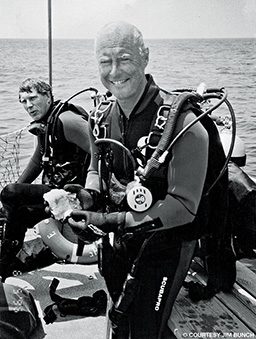Hometown: Kill Devil Hills, N.C.
Years Diving: More than 60 (more than 8,000 dives)
Favorite Destination: North Carolina, especially the U-85
Why I’m a DAN Member: I belong to DAN for the security it offers and the technical and medical articles in Alert Diver magazine.
James Wilkins Bunch was already a legend in North Carolina’s Outer Banks when his second book, Germany’s U-85 — A Shadow in the Sea: A Diver’s Reflections, was published in 2003. The book, about the German submarine U-85, the first U-boat to be sunk off the U.S. East Coast during World War II, has fascinated readers and enthralled divers with its account of the exploration of the sunken vessel and the recovery of its Enigma M4 machine. As a dive instructor and dive shop owner, Bunch has trained and certified hundreds of new divers while introducing them to his passion: the ocean realm.
Jim, you’ve had a long and distinguished career as an instructor, explorer, photographer, historian, author, lecturer and more. But those areas are not exactly what you were trained or educated to do. What did you expect your work life to be?
After high school I headed off to N.C. State for college, and I thought I’d be an engineer. By the second semester it was getting cold; walking across campus one day, I heard a radio blaring about Miami, and I decided to head south. The next year I was studying marine sciences at the University of Miami and spending a lot of time at Miami Beach, Fla. The Vietnam War was heating up, and I joined a Navy flight program. After I graduated from Miami with a degree in marine biology, I earned a master’s degree at Old Dominion University’s Institute of Oceanography in Norfolk, Va. For the next 10 years I worked as a civilian oceanographer with the Army Corps of Engineers.
Where and when did you learn to scuba dive, and how did you get into photography?

As a kid I was always in the water, and I started skin diving by the time I was 7 or 8. I actually learned to dive, sort of, from a retired U.S. Navy Underwater Demolition Team (UDT) diver when I was about 12 years old. A family friend owned a grocery store and ordered some U.S. Divers gear from a catalog for me. I strapped on a steel 72-cubic-foot tank (with a K-valve) with an Aqua-Master double-hose regulator and a weight belt and headed a few hundred yards off shore of Perry’s Drive-In in Kill Devil Hills. Norwood Rector, who had a small dive shop in a garage behind the drive-in, had instructed me to not hold my breath. I told him I wouldn’t and thus completed my training. I had no buoyancy compensator (BC) or any other equipment except the scuba unit, weights, my old Voit Viking fins and Champion mask. When I first saw shipwrecks and realized I could breathe underwater, I was hooked for life.
Later, when I was in Miami, I got certified by Jack Chappell. He ran a dive operation and would take us to the Keys to practice with our double-hose regulators and horse-collar BCs. About the same time I started to learn underwater photography from Jerry Greenberg and some other divers. I bought a Dimitri Rebikoff housing and then a Calypso underwater camera around 1963 and started shooting without strobes. It wasn’t easy getting decent photographs on shipwrecks in the ’60s. You had to be there on a good-visibility day, and without strobes you had to have your technique just right. I learned a thing or two over the years just shooting.

Your photographs of the U-85 adorn your books and are displayed at the N.C. Aquarium on Roanoke Island. How did you become such an expert on the U-85?
I came home from college every summer and dived the wrecks and reefs offshore, and I continued doing it after I went to work as a civilian oceanographer. In the mid-1970s I heard about a submarine 16 miles or so off Nags Head, N.C., and finally got to see it in 1978, when Jim Stuart took me out in his small dive boat. My first dive on it was probably the most exciting experience I’ve had. And the second most exciting was taking divers down to see it and telling people about the history of it. I became an instructor with the National Association of Underwater Instructors (NAUI) in 1980 just to treat other divers to that experience. Later my wife and I started our own dive operation, Sea Scan Dive Center, mostly so I could dive on the U-85.
So finding the Enigma machine was not the most exciting experience you have had while diving?
The recovery of the Enigma was a truly amazing moment for me and my dive buddies, Roger and Rich Hunting and Billy Daniels. We spent many cold, dark and scary hours inside the U-85, and for those dives to culminate in a historical recovery has meant a great deal in my life. Finding the Enigma M4 in 2001 and donating it to the Graveyard of the Atlantic Museum in Hatteras, N.C., where it is on permanent display, was a highlight of my more than 1,000 dives on the submarine. But even more exciting and meaningful to me is how much my teaching and taking people to the U-85 has meant to them. I will always cherish the new divers, young and old, who told me how much I changed their lives, even though I know it was the ocean environment, not me, that really awed them.
The ocean has been my life; the diving has just been the means to experience it — from the time I was a little boy with a homemade spear gun to writing and talking about it today. I’m still surfing, too, when the waves rise.
| © Alert Diver — Q2 2017 |